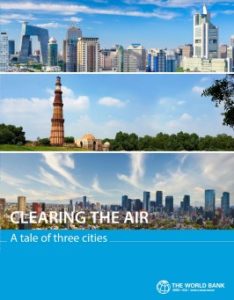How can countries grow their economies and keep air pollution in check at the same time? A new World Bank report explores that tricky question, looking at the kinds of policies and actions three leading cities have taken to tackle poor local air quality, providing lessons for other cities. As we mark World Cities Day on October 31, this research seems more timely than ever.
Air pollution poses a major health risk globally, weighing on economies and people’s health. That’s more than the total number of people who died from HIV/AIDS, tuberculosis, and malaria combined. The cost associated with health impacts of outdoor PM2.5 air pollution is estimated to be US$5.7 trillion, equivalent to 4.8 percent of global GDP, according to World Bank research. On the flip side, the economic lockdowns caused by the pandemic, while devastating for communities, did result in some noticeable improvements in air quality but these improvements were inconsistent, particularly when it came to PM2.5. Improvements nonetheless show what is possible and provide new impetus for needed change.
Agriculture is also an important source, underscoring the multi-faceted and transboundary nature of air pollution. How can cities overcome this issue? The latest World Bank report, Clearing the Air: A Tale of Three Cities, chose Beijing, New Delhi and Mexico City to assess how current and past efforts improved air quality.

In the early 1990s, Mexico City was known as the world’s most polluted city and while there are still challenges, air quality has vastly improved. Daily concentration of SO2 – a contributor to PM2.5 concentrations – declined from 300 µg/m3 in the 1990s to less than 100 µg/m3 in 2018. PM2.5 levels currently are well below the WHO interim target 1 (35 µg/m3). More recently, Beijing was on a list of the world’s most polluted cities, but with targeted policies and programs, average PM2.5 levels fell from around 90 µg/m3 in 2013 to 58 µg/m3 in 2017.
New Delhi was successful in tackling poor air quality in the late 1990s, implementing an ambitious transportation fuel conversion program that provided some relief to its citizens. Unfortunately, air quality levels have deteriorated since then, leading the national and Delhi state governments to implement new action plans that address multiple sources of pollution. Early indications are that air quality is improving although pollution levels remain worrying high. For example, average PM2.5 levels in 2018 were an unhealthy 128 µg/m3.
From examining the trajectory of these cities, we identified three key elements for success:
Reliable, accessible and real-time information helps create momentum for reform
In Mexico City, careful analysis of the impacts of air pollution on children’s health galvanized public support for the city’s first air quality management strategy. India’s National Air Quality Index program put real time data on pollution levels in the hands of citizens, allowing them to take prevention measures and to demand change. And in Beijing, real time and public data from Continuous Emissions Monitors at industrial locations and power plants helped to hold plant operators and regulators accountable.
Incentives to local governments, industry and households must be mainstreamed
Failure to provide such incentives in India in the late 1990s resulted in the government developing plans but not implementing them. This led to India’s Supreme Court stepping in to force the government to implement policy measures. A recent government of India program to provide performance-based grants to cities to reward improvements in air quality is a step in the right direction.
Industry and households similarly need incentives. Beijing, for example, used national government funds to provide subsidies for end-of-pipe controls and boiler retrofits in power plants and factories, rebates for scrapping older vehicles and payments to households that replace coal-fired heating stoves for gas or electric systems. Mexico City gave direct subsidies to drivers of old taxis in exchange for retiring and scrapping inefficient vehicles, along with access to low-cost loans to renovate or buy more efficient vehicles. Fiscal incentives and exemptions from emergency restrictions that require industrial plants to curtail their production when air pollution reaches high levels were also introduced. In the late 1990s, Delhi’s government provided financial incentives to enable 10,000 buses, 20,000 taxis, and 50,000 three-wheelers to convert to Compressed Natural Gas, which has lower emissions than other fossil fuels.
An integrated approach with effective institutions working across sectors and jurisdictions is critical
The Megalopolis Environment Commission in Mexico brought together federal authorities from the ministries of environment, health, and transport with local authorities from Mexico City and 224 municipalities from the neighboring states of Mexico, Hidalgo, Morelos, Puebla, and Tlaxcala. Together, they jointly defined an airshed for Mexico City, and took coordinated action to improve air quality. Poor air quality comes from many sources – households, rural and urban dwellers, the transport industry, the power sector and agriculture – and an institutional structure is needed that facilitates coordination across all these sectors. In China, the ministries of Environmental Protection (now the Ministry of Ecology and Environment), Industry and Information Technology, Finance, Housing and Rural Development, along with the National Development and Reform Commission and National Energy Administration, worked together to issue a five-year action plan for air pollution prevention and control for the entire Jing-Jin-Ji region that surrounds Beijing and includes the municipality of Beijing, municipality of Tianjin, the province of Hebei, and small parts of Henan, Shanxi, inner Mongolia, and Shandong.
What’s encouraging about this new work is that it shows that with the right policies, incentives and information, air quality can be improved substantially, particularly as countries work to grow back cleaner after the pandemic. There is no silver bullet though and At the World Bank, we are committed to working with governments as they manage air pollution, providing analytical work, technical assistance and the lending required to support cities to move in the right direction.